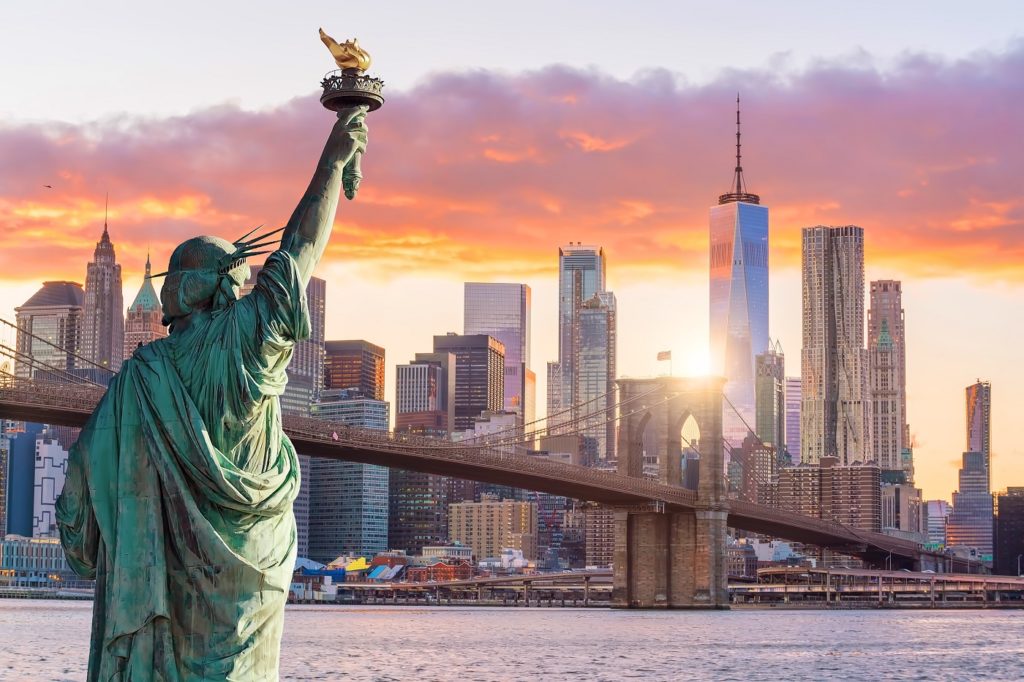President Lyndon Johnson once said, “When the burdens of the presidency seem unusually heavy, I always remind myself it could be worse. I could be a mayor.” 2020 was a calamitous year for almost everyone, but the fiscal crisis precipitated by the COVID epidemic fell especially heavily on the shoulders of our cities’ mayors.
In the large cities of the Northeast and Midwest, the next few years will add to these stresses as businesses relocate, tax revenues decline, commercial properties stand vacant, and crime rates spike. New York, Buffalo, Rochester, and Detroit face revenue drops in 2021 of between 10 and 20 percent. These cities will hold mayoral elections this November, and the victors will be doing a lot more budget cutting than ribbon cutting in their first terms of office. They will have the unenviable and unpopular job of severely curtailing municipal staff and services.
Unfortunately, the leading candidates for mayor in these cities are progressives who have spent their careers campaigning for expensive new government programs, to be paid for by hiking taxes on wealthy residents. In many large American cities, the Democratic primary election determines who becomes mayor, so there is little incentive for mayoral candidates to try to appeal to centrist or conservative voters. Most of the leading Democratic candidates for mayor have little private sector experience, and nearly all of the candidates need public-sector union support to win elections.
New York City’s Mayor Bill de Blasio has emerged as a symbol of America’s ultra-progressive left. His missteps in New York City should serve as a caution to mayors of other cities—and inform their policy decisions.
Start your day with Public Discourse
Sign up and get our daily essays sent straight to your inbox.Mayor de Blasio’s Dystopia
During Mayor de Blasio’s eight years as New York City’s mayor, he has expanded the New York City workforce by 11 percent, negotiated extravagant pay and benefit increases for unionized city employees, added 12,000 employees to the New York City public school system, which now costs taxpayers a whopping $29,000 per year per pupil. In 2020, New York City’s outstanding debt grew to $125 billion. On October 1, 2020, Moody’s Investor Services downgraded New York City’s bond rating, which will increase the city’s borrowing costs. City Council speaker Cory Johnson told the New York Times, “What the mayor has done is extraordinarily irresponsible. He has not gone through the hard process of identifying cuts.”
Mayor de Blasio’s budget office is projecting a budget shortfall of $8.3 billion for the current fiscal year, which runs through June 2021. The Biden administration has succeeded in sending the city relief through its stimulus package, but this relief is only a temporary stopgap measure. Governor Andrew Cuomo calls the federal stimulus “the ultimate one shot . . . sugar high.” E.J. McMahon, founder of the Empire Center, writes, “Federal largesse will only create bigger holes to be filled once this (likely) last and largest hunk of federal aid is spent.” It will allow New Yorkers to delay tough fiscal decisions by one year.
Mayor De Blasio has been cool to business leaders who have offered to help him manage this crisis. In the spring of 2020, a panel of New Yorkers representing industries ranging from the arts to hospitality to finance submitted a twenty-four-page blueprint to restart the local economy. Politico reports that in April the de Blasio administration shelved the panel’s report, dismissing the panel as being “too white” and “too pro-business.”
On September 10, 2020, de Blasio received an open letter from 170 business leaders expressing anxiety at the deterioration of New York’s business environment. Signatories included the chambers of commerce in all five boroughs and executives at Citicorp, Mastercard, and Nasdaq. “There is widespread anxiety over public safety, cleanliness and other quality of life issues that are contributing to deteriorating conditions in commercial districts and neighborhoods across the five boroughs,” the business leaders wrote. “We need to send a strong, consistent message that our employees, customers, clients and visitors will be coming back to a safe and healthy work environment.”
Mayor de Blasio could learn a lot about crisis management from previous mayors who worked closely with business leaders to solve the city’s problems.
The Bloomberg Model
Mayor de Blasio could learn a lot about crisis management from previous mayors who worked closely with business leaders to solve the city’s problems. As a former de Blasio advisor has said, “This is the first mayor in modern history that doesn’t have business leaders on speed dial.”
After 9/11, Mayor Michael Bloomberg partnered with scores of companies to raise money for the city’s recovery. Bloomberg also kept New York on a sound fiscal footing by initiating austerity measures that kept deficits in check. By contrast, De Blasio’s proposed $92 billion budget for fiscal year 2022 contains a paltry 2 percent cut in expenses that will do nothing to improve the fiscal health of the city. De Blasio’s spending “cuts” consist mostly of “spending delays and re-estimates instead of program efficiencies,” said Andrew Rein, president of the Citizens Budget Commission.
Mayor de Blasio approved $1 billion in cuts to the police force, for example, but these reductions included “paper cuts” in police overtime pay that the city has found it impossible to implement. De Blasio has also cancelled the NYPD’s incoming class of 1,160 new officers, even though homicides in New York surged by 41 percent and shootings surged by 95 percent in 2020.
For every dollar that the department pays in an officer’s salary, it spends nearly as much on pensions and healthcare for workers and retirees, and de Blasio has done nothing to reduce those costs.
When de Blasio took office in 2013, he reversed Bloomberg’s policy of extracting concessions from public-sector unions. Instead, de Blasio granted city employees retroactive pay increases stretching back to 2009. New York is unique among large cities in paying almost the entire cost of healthcare for city workers and retirees. De Blasio’s promises to retirees alone amount to more than $100 billion in unfunded future costs for the city.
During his tenure, Bloomberg vastly expanded New York City’s network of charter schools, which spends $5,000 less per student per year than district schools, with dramatically better results. De Blasio, on the other hand, has waged a relentless war against charter schools while pouring nearly $1 billion into an ineffective Renewal program designed to turn around failing public schools. In 2019, de Blasio admitted that this program had failed and shut it down.
Progressives routinely call on city governments to tax wealthy people to make up budget gaps, but high taxes are already causing an epidemic of tax flight. In 2019, just one tenth of one percent (4,000 out of 4 million) of New York City tax filers paid 30 percent of the city’s income taxes. Last year’s remote working environment has shown wealthy New Yorkers that they can save huge amounts of money by working from a red state. Florida, for example, has no income tax, compared with New York City’s 12.7 percent. Goldman Sachs recently announced its intention to move its $8 billion asset management arm to Florida. Billionaires Paul Singer and Carl Icahn have both moved the management of their hedge fund operations to Florida. The Partnership for New York City reports that fewer than 15 percent of the city’s office workers have returned to their pre-pandemic workplaces.
Fiscal Control Boards
If financially strapped cities of the Northeast are going to get on a sound fiscal footing, the next mayors will have to make drastic budget cuts. Perhaps the only way to make such budget cuts politically palatable is to submit the city budgets to state oversight and financial control boards.
Since the 1970s, states have devised a variety of tools to attack distressed local budgets. In the American system, cities are creatures of their state governments, and this gives states the authority to exercise almost unlimited power over governance at the local level. States can empower oversight boards to make painful budget cuts and to modify public sector contracts that are the biggest single drain on municipal spending.
New York state’s Financial Control Board (FCB) was created in 1975, when New York City was on the verge of bankruptcy. After New York City’s banks stopped lending the city money to paper over its debts, the state of New York vested the Board with the power to reject or change the city’s budgets and labor contracts. The FCB was composed of four public officials and three corporate representatives, and they forced substantial budget cuts on New York. They eliminated 15,000 city jobs, closed public hospitals, hiked transit fares, and imposed tuition costs on CUNY students for the first time in history. The period of FCB control lasted for ten years, after which the Board’s role shifted to an advisory one. Former Lieutenant Governor of New York Richard Ravitch credits the Board with bringing New York’s fiscal chaos under control in the 1970s. E.J. McMahon said that New Yorkers will once again be open to fiscal control “when they are broke, and they stop fantasizing about moonbeams from Washington.”
In 2010, the state of Michigan passed a similar law giving state-appointed “emergency managers” sweeping powers over the finances, contracts, and policy-making of cash strapped cities and school districts. These state appointees held unilateral power over labor contracts, local budgets, and public assets.
Elected officials often rail against control boards as undemocratic, but a smart mayor might find it advantageous to remove painful budgetary decisions and contract negotiations from his plate. Ravitch said, “Every time the control board forced the city to cut an expenditure, like to reduce the number of garbage pickups to save money in the sanitation budget, Mayor Ed Koch would go on television and criticize the control board. When he got off camera, he would turn to me and say, ‘Thank God for the control board.’”
The 2021 federal bailout of our cities and states will only delay by a year or two our cities’ inevitable fiscal reckoning with runaway spending and declining revenues. After Washington’s spending spree ends, our cities’ mayors will once again find themselves back on their heels. As the pandemic winds down, mayors will need to work especially hard to make their cities attractive again. With or without the help of fiscal control boards, they will need to dramatically change their spending habits in order to balance their budgets and revive economic growth. There is no other path to recovery.














